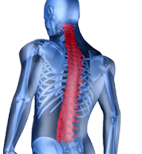Lumbar Facet Injection
What are Lumbar Facet Joints?
Facet joints connect the vertebrae (the bones of the spine) and help guide the spine during movement. The lumbar region of the spine contains five vertebrae and is located in the lower back.
Facet joints are found on both sides of the spine. Each is about the size of a thumbnail. Lumbar facet joints are named for the vertebrae they connect and the side of the spine where they are found. The L4-5 facet joint, for example, joins the 4th and 5th lumbar vertebrae.
Lumbar Facet Joint Pain
Lumbar facet joint pain is a result of injury, either to the cartilage inside the joint or the connecting ligaments surrounding the joint.
Pain from an injured lumbar facet joint may range from muscle tension to more severe pain. Depending on which facet joint is affected, the pain may occur in an area from your lower back down to your buttocks.
How do I know if I have Lumbar facet pain?
If you have pain in one or more of these areas when you bend your back, and it has lasted longer than two months, you may have lumbar facet pain. Common tests such as X-rays or MRIs may not always show if a facet joint is causing your pain.
Procedure Detail
You may be given oral Valium or IV (intravenous) medication to help you relax. You may lie down with face down on the procedure table. The lumbar spine is identified under fluoroscopy (a type of X-ray is used to ensure the safe and proper position of the needle). A local anesthetic is used to numb your skin. The doctor will then insert a thin needle directly into the facet joint. A small amount of dye may be injected to confirm the position of the needle.
Once the physician is sure the needle is correctly placed, a local anesthetic (numbing medicine) and a corticosteroid (anti-inflammatory medicine) are injected into one or more lumbar facet joints.
The injection can be used to diagnose or treat. If the injection temporarily lessens your pain and helps you move better, your doctor will know which facet joint is causing the pain. The corticosteroid is used to treat inflammation of the facet joint.
Post Procedure
You will be observed for at least 10-15 minutes in the recovery room for your response to the injection. Your oxygen level, blood pressure, pulse rate, and respiratory rate will be monitored in the recovery room. You may become a little sore at the soft tissues of the procedure site, which is normal and to be expected. You may apply an ice-pack to the sore area of the procedure site. The soreness at the procedure site should go away in a couple of days. It usually takes 48 to 72 hours to experience relief from the long-acting anti-inflammatory steroid agent. A follow-up appointment will be made for you.
You should be able to return to work the day after the injection, but always check with your doctor.
How long can I expect pain relief?
Depending on the number of injured areas and the amount of inflammation, an injection could offer several months of pain relief before further treatment is needed. If there is no underlying bone or joint problem, one injection could bring long-term pain relief. If your pain is caused by injury to more than one area, only some of your symptoms may be helped by one injection.



